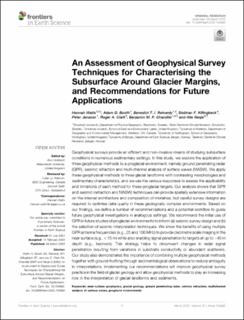| dc.contributor.author | Watts, Hannah | |
| dc.contributor.author | Booth, Adam D. | |
| dc.contributor.author | Reinardy, Benedict T. I. | |
| dc.contributor.author | Killingbeck, Siobhan F. | |
| dc.contributor.author | Jansson, Peter | |
| dc.contributor.author | Clark, Roger A. | |
| dc.contributor.author | Chandler, Benjamin M. P. | |
| dc.contributor.author | Nesje, Atle | |
| dc.date.accessioned | 2023-02-27T09:34:39Z | |
| dc.date.available | 2023-02-27T09:34:39Z | |
| dc.date.created | 2022-05-01T13:08:54Z | |
| dc.date.issued | 2022 | |
| dc.identifier.issn | 2296-6463 | |
| dc.identifier.uri | https://hdl.handle.net/11250/3054103 | |
| dc.description.abstract | Geophysical surveys provide an efficient and non-invasive means of studying subsurface conditions in numerous sedimentary settings. In this study, we explore the application of three geophysical methods to a proglacial environment, namely ground penetrating radar (GPR), seismic refraction and multi-channel analysis of surface waves (MASW). We apply these geophysical methods to three glacial landforms with contrasting morphologies and sedimentary characteristics, and we use the various responses to assess the applicability and limitations of each method for these proglacial targets. Our analysis shows that GPR and seismic (refraction and MASW) techniques can provide spatially extensive information on the internal architecture and composition of moraines, but careful survey designs are required to optimise data quality in these geologically complex environments. Based on our findings, we define a number of recommendations and a potential workflow to guide future geophysical investigations in analogous settings. We recommend the initial use of GPR in future studies of proglacial environments to inform (a) seismic survey design and (b) the selection of seismic interpretation techniques. We show the benefits of using multiple GPR antenna frequencies (e.g., 25 and 100 MHz) to provide decimetre scale imaging in the near surface (e.g., < 15 m) while also enabling signal penetration to targets at up to ∼40 m depth (e.g., bedrock). This strategy helps to circumvent changes in radar signal penetration resulting from variations in substrate conductivity or abundant scatterers. Our study also demonstrates the importance of combining multiple geophysical methods together with ground-truthing through sedimentological observations to reduce ambiguity in interpretations. Implementing our recommendations will improve geophysical survey practice in the field of glacial geology and allow geophysical methods to play an increasing role in the interpretation of glacial landforms and sediments. | en_US |
| dc.language.iso | eng | en_US |
| dc.publisher | Frontiers Media | en_US |
| dc.rights | Navngivelse 4.0 Internasjonal | * |
| dc.rights.uri | http://creativecommons.org/licenses/by/4.0/deed.no | * |
| dc.title | An Assessment of Geophysical Survey Techniques for Characterising the Subsurface Around Glacier Margins, and Recommendations for Future Applications | en_US |
| dc.type | Journal article | en_US |
| dc.type | Peer reviewed | en_US |
| dc.description.version | publishedVersion | en_US |
| dc.rights.holder | Copyright 2022 Watts, Booth, Reinardy, Killingbeck, Jansson, Clark, Chandler and Nesje | en_US |
| dc.source.articlenumber | 734682 | en_US |
| cristin.ispublished | true | |
| cristin.fulltext | original | |
| cristin.qualitycode | 1 | |
| dc.identifier.doi | 10.3389/feart.2022.734682 | |
| dc.identifier.cristin | 2020395 | |
| dc.source.journal | Frontiers in Earth Science | en_US |
| dc.identifier.citation | Frontiers in Earth Science. 2022, 10, 734682. | en_US |
| dc.source.volume | 10 | en_US |

